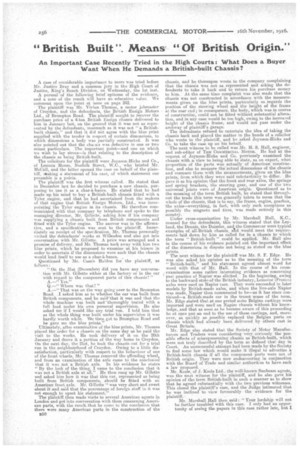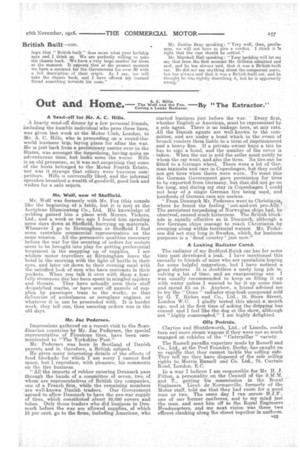"British Built ". Means "Or British Origin.
Page 16

Page 17

If you've noticed an error in this article please click here to report it so we can fix it.
An Important Case Recently Tried in the High Courts : What Does a Buyer Want When He Demands a British-built Chassis ?
A case of considerable importance to users was tried before Mr. Justice Bray and a common jury in the High Court of Justice, King's Bench Division, on Wednesday, the 1st inst.
A perusal of the following brief 'epitome of the evidence, and a note of the result will have an educative value. We comment upon the point at issue on page 242. • The plaintiff was Mr. Vivian Thomas, a motor jobmaster of Croydon, and the defendants, the British Ensign Motors Ltd., of Brompton Road. The plaintiff' sought to recover the purchase price of a 4-ton British Ensign chassis delivered to him in January last, on the ground that it was not as repretented by the defendants, inasmuch as it was not "a Britishbuilt chassis," and that it did net agree with the blue print supplied with the tender in respect of certain dimensions, to which dimensions a body was partially constructed. It was also pointed out that the chassis was defective in one or two minor particulars. The important point—and one on which we wish to lay stress—is that relating to the description of the chassis as being British-built. The solicitors for the plaintiff were Joynson-Hicks and Co., of Lennox House, Norfolk Street, W.O., who briefed Mr. McCall, and the latter opened the case on behalf of the plaintiff, staking a statement of his case, of which statement our preamble is a precis. The plaintiff was the first witness called. He stated that in December last he decided to purchase a new chassis, purposing to use it as a char-a-bancs. He stated that he had made up, his mind to buy a British-built chassis fitted with a Tvlor engine, and that he had ascertained from the makers of that engine that British Ensign Motors, Ltd., was incorporating the Tylor engine in its chassis. He therefore Corn • iminicated with that company by telephone and spoke to the managing director, Mr. Gillette, asking _him if his company was supplying a chassis built from British components and fitted with the Tylor engine. The answer was in the affirmative, and a specification was sent to the _plaintiff. Immediately on receipt of the specification, Mr. Thomas personally visited the defendants' works at Willesden and also got into conversation with Mr. Gillette. A price was arranged and a promise of delivery, and Mr. Thomas took away with him two blue prints, which he proposed to examine at his leisure in order to ascertain if the dimensions were such that the chassis would, lend itself to use as a char-a-bancs. „ Questioned by Mr. Cassie Holden for the plaintiff, as follows: "On the 31st (December) did you have any conversation with Mr. Gillette either at the factory or in the car with regard to the component parts of this chassis? "
A.—" Yes."
Q.—" Where was that? "
A.—" That was on the way going over to the Brampton Road. . I asked him as to whether the car was built from British components, and he said' that it was and that the whole machine was built and'thoroughly tested with a full load under his own personal supervision. He also asked me if I would like any trial eun. I told him that as the whole thing was built under his supervision it was hardly worth while. We then gut to Brompton Road and he gave me the blue prints."
Ultimately, after examination of the blue prints, Mr. Thomas placed the order for a chassis on the same day as he paid the visit to the works. He took delivery of it on the 20th January and drove it a portion of the way home to Croydon. On the next day, the 21st, he took the chassis out for a trial run in the neighbourhood of Croydon. Owing to a little dissatisfaction, particularly with respect to the behaviour of one of the front wheels, Mr. Thomas removed the effending wheel, and from an examination of the axle came to the conclusion' that it V. a.,.; not a British axle. In his evidence he states " By the look of the thing, I came to the conclusion that it was not a British axle at all." He then rang up Mr. Gillette and asked him how it was that this car, represented as being built from British components, should be fitted with an American front axle. Mr. Gillette "was very short and sweet about it and said that the percentage of foreign stuff in it was not enough to upset his statement. '
The Plaintiff then made visits to several American agents in London and got into conversation with them concerning American parts, with the result that he came to the conclusion that there were many American parts in the construction of the 850 chassis, and he thereupon wrote to the company complaining that the chassis was not as represented and asking the defendants to take it back and to return his purchase money to him. At the same time complaint was also made that the chassis was not constructed in accordance with the measurements given on the blue prints, particularly as regards the position of the steering wheel and the height of the frame at the rear end; in consequence, the body, which was in course of construction, could not be fitted without substantial alteration, and in any case would be too high, owing to the increased height of the chassis frame, and would not pass under the archway of plaintiff's garage. The defendants refused to entertain the idea. of taking the chassis back and placed the matter in the hands of a solicitor who wrote to the plaintiff, and he asked Joynson-Hicks and Co, to take the case up on his behalf.
The next witness to he called was Mr. H. S. Hall, engineer, and sub-editor of THE COMMERCIAL MOTOR. He had at the request of Joynson-Hicks and Co. previously examined the chassis with a view to being able to state, as an export, what proportion of the parts was actually of American construction, and also to measure Ihe actual dimensions of the chassis and compare them with the measurements, given on the blue prints, from which they were said substantially to differ. He gave it as his opinion that the front and rear axles, the springs and spring brackets, the steering gear, and one of the two universal joints were of American origin. Questioned as to the meaning of the term British built, he stated that throughnut the trade this term was generally taken to mean that the whole of the chassis, that is to say, the frame, engine, gearbox, the axles—everything, in fact, with only such exceptions as possibly the magneto and tires, was made entirely in this country.
Under cross-examination by Mr. Marshall Hall, K.C., counsel for the defendants, this witness stated that the -Ley. land, the Dennis, the Daimler, and the Commercar were typical examples of all-British chassis, arid would meet the require, ments laid down by him as called for in a chassis to which the term " British built" could be applied. Mr. Hall also in the course of his evidence pointed out the important effect of the dimensions in dispute not being as stated on the blue prints.
The next witness for the plaintiff was Mr. S. F. Edge. He was also asked his opinion as to the meaning of the term " British-built," and his statement agreed almost word for word with that of Mr. Hall. In the course of his crossexamination some rather interesting evidence as concerning ( pest practice of Napier was elicited. In the beginning, owing to the backwarj state of the British industry, Lemoine (French) axles were used on Napier cars. They were succeeded in later models by British-made axles, and when the live-axle Napier was made, Napier then commenced to be—as it has since continued—a British-made car in the truest sense of the term. Mr. Edge stated that at one period seine Belgian castings were imported and were used on Napier chassis without his knowledge, and that as soon as he became aware of this proceeding he at once put an end to the use of these castings, and, moreover, as quickly as possible replaced the Belgian parts on chassis which' had already been delivered by others cast in Great Britain.
Mr. Edge also stated that the Society of Motor Manufacturers and Traders were considering very seriously the possible effects of misrepresenting chae:sis as British-built, which were not truly described by the term as defined that day. in Court. An unsuccessful attempt had been made by the Society to find some law which would make it illegal to advertise a British-built chassis if all the component parts were not of British origin. They were now endeavouring in conjunction with the Board of Trade and similar authorities to have such a law proposed.
Mr. Keels, of J. Keele Ltd., the well-known Sunbeam agents, was the nest witness for the plaintiff, and he also gave his opinion of the term British-built in such a manner as to show that he agreed substantially with the two previous witnesses. This closed the plaintiff's case, and the Judge intimated that he was inclined to view favourably the evidence for the plaintiff. Mr. Marshall Hall then said: "Your lordship will not be further troubled with this case. I only had an opportunity of seeing the papers in this case rather late, but I
hope that " British-built " does mean what your lordship says and I think soWe are perfectly willing to take the chassis back. We have a very large market for them at the moment. It appears that at the present moment we have a contract for the Government for over 30 with a full description of their origin. As I say, we will take the chassis back, and I have offered my learned friend something towards his costs." Mr. Justice Bray speaking.: "Very well, then, gentlemen, we will not have to ove a verdict. I think it la right that the case should be settled."
Mr. Marshall Hall speaking "Your lordship will let me say that from the first moment Mr. Gillette admitted and said, and he has always said, that it was a British-built car. He did not say anything about the component parts, but has always said that it was a British-built car, and he thought he was -rightly describing it, but he is apparently wrong."






















